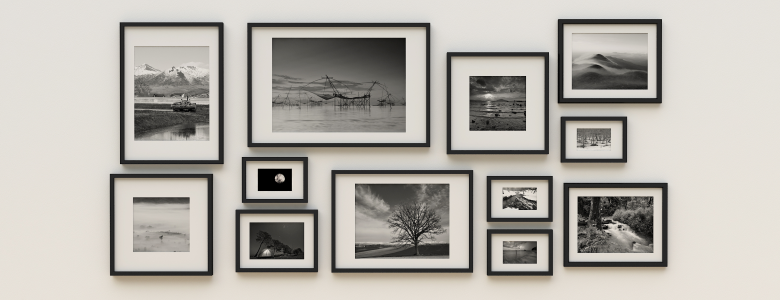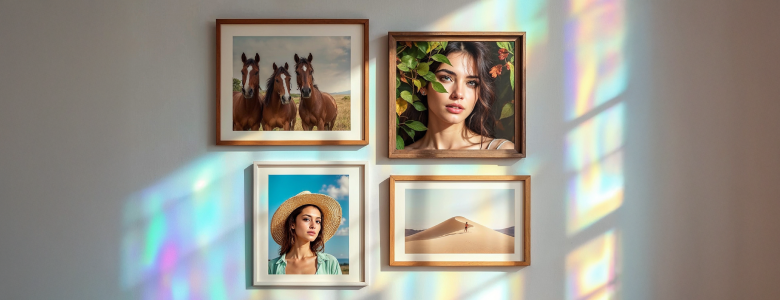Every print deserves a finish that does it justice. Whether it’s a striking photo, detailed artwork, or a large-format poster, the way it’s framed and mounted plays a big role in how it’s viewed, handled, and preserved. Some pieces need structure, others need protection, and, in most cases, the right frame or mount can do both.
This guide takes you through practical choices in frames and mounts for prints—from foamcore vs mat board mounting to options like UV-protective frames for art prints or floating frame for canvas art. Whether you’re displaying in a personal space or planning a full wall setup, the right finish can change everything.
The Purpose of Framing and Mounting
Every print deserves a structure. Frames and mounts for prints are not only functional—they shape the viewer’s experience. A well-framed image looks sharper, cleaner, and more complete. A properly mounted print is easier to hang and keeps its shape over time.
More importantly, they help protect your work. From UV exposure to bending and corner damage, framing and mounting prevent wear while extending display life.
Start with the Format of the Print
Before choosing frames or mounts, consider what you’re working with. The material, finish, and weight of the print will guide your decision.
- Paper posters and photographs need flat, smooth support
- Fine art prints benefit from layered presentation and protection
- Canvas prints require structure but no glazing
The print format often dictates whether matting is necessary or if a floating effect will look better. This is the foundation of smart framing.
Foamcore vs Mat Board Mounting
Mounting adds stability. Two common materials are used: foamcore and mat board. Knowing the differences helps you make the right choice for your application.
Foamcore Mounting
- Lightweight and rigid
- Available in white and black
- Comes in thicknesses like 3/16″ or 1/2″
- Often used for posters, large prints, or frameless presentations
Foamcore is best when the print needs to remain flat and easy to install. It’s clean, cost-effective, and looks polished with or without a frame.
Mat Board Mounting
- Thinner board, usually around 1/16″
- Adds a clean border and keeps the print off the glazing
- Paper-based and presentation-friendly
Mat board is commonly used in classic professional print framing. It offers a more refined look and is essential when glazing is involved.
Understanding foamcore vs mat board mounting helps you decide based on durability, cost, and presentation needs.
Mat vs Foamcore Mounting Prints: When to Use Each
You don’t always need to frame your print. Sometimes, mounting alone provides the finish you want. Here’s when to use each type:
- Use foamcore when weight matters or the print will be displayed without glass
- Choose mat board for framing behind glass, especially in galleries or retail setups
This balance of cost, style, and functionality is what makes the mat vs foamcore mounting prints decision so important.
Best Mounting Boards for Photo Prints

Photo prints have specific needs. Surface quality and print finish must be preserved. The best mounting boards for photo prints are those that provide a smooth, acid-free backing with good rigidity.
Use:
- Foamcore for clean presentation in albums, frames, or stand-alone pieces
- Mat board for matted framing that brings contrast and depth
- Acid-free backing for long-term storage or archiving
For detailed or high-resolution prints, flatness and stability matter most. A warped or sagging print loses impact and professionalism.
Custom Print Frames: Tailored for Impact
Every print deserves a frame that fits both its size and its style. Custom print frames give you flexibility—especially when standard sizes don’t work.
Choose:
- Frame materials (wood, composite, matte black, metallics)
- Frame thickness and depth
- Options for canvas depth and paper print mounting
- Matching color tones to complement the print
These are often used when you need a tailored look for a collection, a series, or a one-off display that stands out.
Floating Frame for Canvas Art
Canvas prints don’t need glass. They have their own structure. A floating frame for canvas art creates a subtle border that allows the entire print to be visible even the sides.
Floating frames:
- Create clean, modern lines
- Work well for abstract or full-bleed art
- Give a gallery-style effect
They’re perfect when you want an understated look that still feels professional.
Choosing Glass vs Acrylic Glazing
For framed prints that require glazing, you’ll choose between glass and acrylic. Each has its role depending on the setting.
- Glass gives a crisp view and is scratch-resistant
- Acrylic is lighter and less breakable—ideal for large prints or public installations
When framing in high-traffic or high-light areas, consider UV‑protective frames for art prints. These reduce fading and help preserve the colors.
Knowing when you’re choosing glass vs acrylic is essential for long-term print care and safety.
Conservation Framing for Prints
Some prints need more than just structure—they need to be preserved. Conservation framing for prints uses materials and methods that extend the life of the print without altering it.
Conservation includes:
- Acid-free backing and matting
- UV-filtering glazing
- Non-invasive mounting (hinged corners, no adhesives on the print)
- Sealed frame backs to prevent dust or humidity
This is especially useful for signed artwork, limited editions, or pieces intended for resale or exhibition.
Print Framing Tips for Everyday and Professional Use
Here are key print framing tips to keep in mind:
- Always handle prints with clean, dry hands or gloves
- Use spacers if glazing touches the print
- Go with lighter materials for temporary or mobile displays
- Add matting for contrast and separation inside the frame
- Choose frames that don’t overpower the image
Clean lines and thoughtful proportions go a long way in professional presentation.
Frames and Mounts for Prints by Type
To help choose the right combo, here’s a simple layout you can follow:
| Print Type | Mount Type | Frame or Finish |
| Posters | Foamcore | Thin black or white frame |
| Fine art prints | Mat board | Custom wood or metal frame |
| Photo prints | Foamcore or mat | Protective glazing + thin frame |
| Canvas prints | Stretched or floated | Floating frame, no glazing |
| Large art reproductions | Foamcore | Composite frame with depth |
Each setup offers a clear path from print to display-ready product.
UV-Protective Frames for Art Prints
Prints displayed near windows, gallery lights, or in well-lit rooms are at risk of fading. UV-protective frames for art prints use special glazing to filter light and prevent discoloration.
This type of protection is key if your prints will hang long-term in direct or bright light. UV glazing is often combined with archival matting and foam board for a complete conservation system.
Materials Commonly Used in Print Finishing
Print presentation often comes down to the right combination of materials. These influence the final look, weight, and longevity of the piece.
- Foam board mounting is frequently chosen for lightweight installations and prints that need to stay flat without added bulk.
- Mat board works well when layering is required—especially in archival setups or framed displays with glazing.
- For depth and dimensionality, floating frames for canvas art are often paired with stretched canvas.
- Finishes like custom print frames in wood, metal, or composite materials help shape the overall presentation.
- Where glare and fading are a concern, options that include glass or acrylic glazing with or without UV protection are often selected.
Each of these choices plays a distinct role in display settings, from gallery walls to retail interiors and curated home décor.
Framing It All Together
Framing and mounting are more than technical decisions—they define how your work is seen. By choosing the right combination of support, structure, and finish, you turn any print into something display-worthy.
Whether you’re showcasing art in a gallery, producing large prints for retail interiors, or framing a personal photograph, the same rules apply. Use clean mounting, choose glazing that fits the environment, and pick a frame that suits both the print and the space it’s in.
Let your display speak clearly. Start with the right foundation.





No Comments